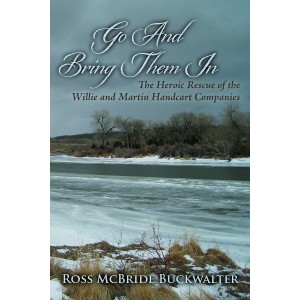Welcome, Log in
Categories
Information
-

Extraordinar... -

How to Ride... -

Unselfish -

Biblical... -

Frogs Matter... -

The 7 Acts... -

Sacred and... -

One Hundred... -

Reflections... -

The Heart of... -

The Way of... -

8 Attributes... -

Preserve,... -

8 Steps to... -

Twelve... -

8 atributos... -

Life is... -

Plan on... -

Silent Sermons -

Servie's Song -

The Cultural... -

Heavenly... -

Melting the... -

Fifty-Five... -

The Way of... -

Church or... -

Down But Not... -

Unselfish Kids -

The Secret... -

Perfect in...
Franklin D. Richards, just released as president of the LDS Church’s European Mission, based in London, arrived in Salt Lake City in the company of several other returned missionaries on October 4, 1856. They immediately met with Brigham Young and other leaders and gave them the news that there were two more handcart companies on the plains en route to Utah. The Richards party had passed these companies on the trail in early September and realized that, because those with handcarts traveled much more slowly, they were still a long distance from Salt Lake City. The leaders in Salt Lake had been well aware of three handcart companies crossing the plains that year; two companies had arrived in Salt Lake City on September 26 and the third a few days later. All were greeted with a celebration of their accomplishments and welcomed into the city, but they had no idea there were two more companies still out. The mood quickly changed from a celebratory one to one of great concern for the safety of these additional groups. President Young and the other leaders immediately realized the gravity of the situation: the two companies still out were made up of several hundred immigrants from Europe. They included men, women, and children, who had no experience at all on the plains and were traveling with a minimum of food and supplies. The leaders realized that as the season got later these people could be in a very dangerous situation. This news, concerning as it was, could not have come at a better time. The next day, Sunday, October 5, was the semi-annual Mormon general conference, and people from Salt Lake and the surrounding communities would be gathering in the Tabernacle to hear from their leaders. Brigham Young realized that they must get a rescue effort started as soon as possible, and the conference presented the perfect opportunity to gather volunteers. In the morning session of conference, Brigham Young arose to speak and immediately told the congregation about the situation and what was needed. Many of our brethren and sisters are on the plains with handcarts, and probably many are now 700 miles from this place, and they must be brought here, we must send assistance to them . . . and bring them in before winter sets in. President Young asked those who were willing to join the rescue party to “give their names this morning, if they are ready to start on their journey tomorrow, and not say, ‘I will go next week, or in ten days, or in a fortnight hence,’ for I wish you to start tomorrow morning. . . . You may rise up now and give your names.” He also asked the women of the Church to help by providing blankets and clothing for those in the handcart companies. Lucy Meserve Smith, who was Relief Society President in Provo, recorded: “The sisters stripped off their Peticoats, stockings and everything they could spare, right there in the Tabernacle to be packed with foodstuffs into wagons.” Thus began one of the most incredible rescue efforts in the history of the West. This volume tells the story of the heroic efforts made by the rescuers over the ensuing two months. They voluntarily put themselves at great risk; they were away from home and family much longer and had to travel much farther, through more difficult weather conditions, than anyone anticipated as they answered Brigham Young’s call to “go and bring in those people now on the plains.” Quoting Wallace Stegner: Perhaps their suffering seems less dramatic because the handcart pioneers bore it meekly, praising God, instead of fighting for life with the ferocity of animals. . . . And assuredly the handcart pilgrims were less hardy, less skilled, less well equipped to be pioneers. But if courage and endurance make a story, if human kindness and helpfulness and brotherly love in the midst of raw horror are worth recording, this half-forgotten episode of the Mormon migration is one of the great tales of the West and of America.
Cart
No products
Shipping
$0.00
Total
$0.00
New products
No new product at this time
Specials
No specials at this time







